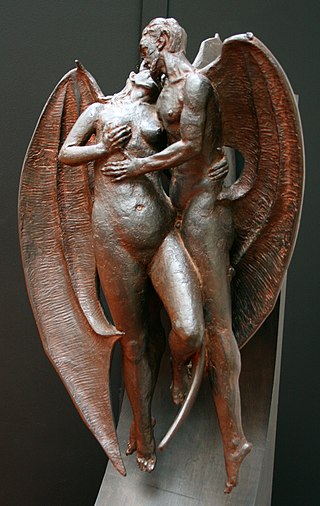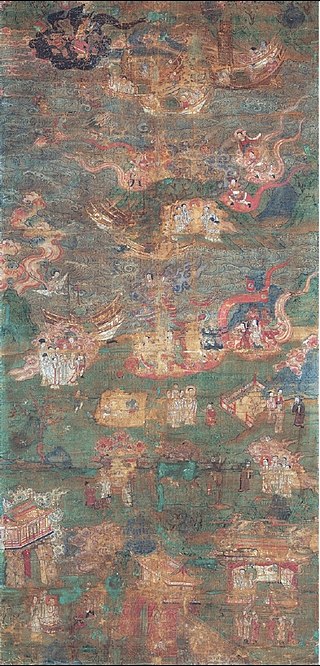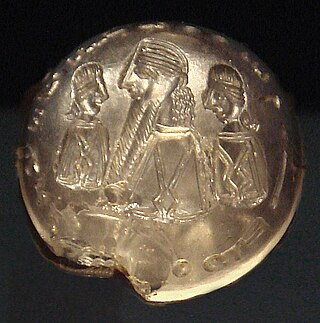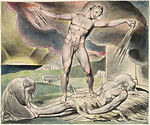
A demon is a malevolent supernatural entity. Historically, belief in demons, or stories about demons, occurs in religion, occultism, literature, fiction, mythology, and folklore; as well as in media such as comics, video games, movies, and television series.

A devil is the personification of evil as it is conceived in various cultures and religious traditions. It is seen as the objectification of a hostile and destructive force. Jeffrey Burton Russell states that the different conceptions of the devil can be summed up as 1) a principle of evil independent from God, 2) an aspect of God, 3) a created being turning evil, and 4) a symbol of human evil.

Manichaeism is a former major religion founded in the 3rd century AD by the Parthian prophet Mani, in the Sasanian Empire.

Fallen angels are angels who were expelled from heaven. The literal term "fallen angel" doesn't appear in any Abrahamic religious texts, but is used to describe angels cast out of heaven or angels who sinned. Such angels often tempt humans to sin.

The Arzhang, also known as the Book of Pictures, was one of the holy books of Manichaeism. It was written and illustrated by its prophet, Mani, in Syriac, with later reproductions written in Sogdian. It was unique as a sacred text in that it contained numerous pictures designed to portray Manichaean cosmogony, which were regarded as integral to the text.
Jason David BeDuhn is a historian of religion and culture, currently Professor of Religious Studies at Northern Arizona University.
Dualism in cosmology or dualistic cosmology is the moral or spiritual belief that two fundamental concepts exist, which often oppose each other. It is an umbrella term that covers a diversity of views from various religions, including both traditional religions and scriptural religions.
In theology, divine light is an aspect of divine presence perceived as light during a theophany or vision, or represented as such in allegory or metaphor.

Mar Ammo was a 3rd-century Manichean disciple of the prophet Mani. According to Manichaen tradition he spread Manichaeism eastward into Sogdiana during the time period when Mani was living. Mar Ammo is well known as the apostle of the east in Manichean literature nevertheless his exact origins are unknown. His Syriac name may denote that he was Syrian in origin. However, a Parthian origin may also be seen and is mentioned by some scholars, especially due to his outstanding role in establishing the Parthian language as the official language of the eastern Manichean Church, later to be replaced by Sogdian in the sixth century. Furthermore, Mar Ammo is widely regarded as the composer of the Manichaean Parthian hymn-cycles.

Johannes (Hans) van Oort is a Dutch academic who is the Professor of Patristics and Gnostic Studies at Radboud University, Nijmegen, and at the University of Pretoria, South Africa. He is best known for his specialty in the study of St. Augustine, the gnostic world religion of Mani (Manicheism), and the Gospel of Judas. In 2006 van Oort presented, with the National Geographic Society, the discovery of this gnostic “gospel” to the Dutch speaking world.

Chinese Manichaeism, also known as Monijiao (Chinese: 摩尼教; pinyin: Móníjiào; Wade–Giles: Mo2-ni2 Chiao4; lit. 'religion of Moni') or Mingjiao (Chinese: 明教; pinyin: Míngjiào; Wade–Giles: Ming2-Chiao4; lit. 'religion of light' or 'bright religion'), is the form of Manichaeism transmitted to, and currently practiced in, China. It rose to prominence during the Tang dynasty and, despite frequent persecutions, has continued long after the other forms of Manichaeism were eradicated in the West. The most complete set of surviving Manichaean writings were written in Chinese sometime before the 9th century and were found in the Mogao Caves among the Dunhuang manuscripts.

The Father of Greatness is the eternal divine manifestation of good in Manichaeism, a four-fold deity, embracing divinity, light, power and goodness. His throne is surrounded by at least 156 peaceful entities: 12 aeons, aeons of the aeons and angels.

Augustinian Calvinism is a term used to emphasize the origin of John Calvin's theology within Augustine of Hippo's theology over a thousand years earlier. By his own admission, John Calvin's theology was deeply influenced by Augustine of Hippo, the fourth-century church father. Twentieth-century Reformed theologian B. B. Warfield said, "The system of doctrine taught by Calvin is just the Augustinianism common to the whole body of the Reformers." Paul Helm, a well-known Reformed theologian, used the term Augustinian Calvinism for his view in the book "The Augustinian-Calvinist View" in Divine Foreknowledge: Four Views.
Asrestar is a class of demons in Manichaeism. They appear prominently in the Manichaean creation myth, especially the creation of mankind. Accordingly, Az decided to create humans in the image of the Third Messenger and mingled the demonic asrestar with the light particles, that is basically the soul. Although most asrestar are indistinguishable, an eminent demon called Šaklūn, features as demiurgic demon entrapping humans in the material world during the Adam and Eve narration. Human's urges for evil, such as lying, are remaining parts of the asrestar within the body.

In Manichaeism, Jesus is considered one of the four prophets of the faith, along with Zoroaster, Gautama Buddha and Mani. He is also a "guiding deity" who greets the light bodies of the righteous after their deliverance.

Manichaean Temple Banner Number "MIK Ⅲ 6286" is a Manichaean monastery flag banner collected in Berlin Asian Art Museum, made in the 10th century AD. It was found in Xinjiang Gaochang by a German Turpan expedition team at the beginning of the 20th century. The flag streamer is 45.5 cm long and 16 cm wide, with painted portraits on both sides. It is a funeral streamer dedicated to the deceased Manichae believers.

The Birth of Mani is a Manichean silk cloth color painting painted in the Fujian Zhejiang area during the Yuan period, depicting the founder of the sect Mani The scene of birth, a scholar who specializes in Manichaeism Ma Xiaohe called it "a rare treasure". This picture is now in the collection of Japan Kyushu National Museum. The drawing technique and artistic style are similar to "Mani's Community Established" and "Mani's Parents", "The Birth of Mani" and "Manichean Universe Map". " It was originally part of a large-scale Manichean silk painting, but now the silk painting has been lost, leaving only the birth picture.

Episodes from Mani's Missionary Work is a Manichean silk color painting drawn in the coastal area of southern China during the yuan to ming period. It is now in a private Japanese collection. The whole picture can be roughly divided into five scenes, depicting the missionary process of a Manichean elector. According to Hungary Asian religious art historian Zsuzsanna Gulácsi, this priest is probably the founder of Manichaeism Mani himself. This painting was originally part of a large-scale Manichean silk painting. The drawing technique and artistic style are similar to "Mani's Community Established" and "Mani's Parents", "The Birth of Mani" and "Manichean Universe Map".

Manichaeism has a rich tradition of visual art, starting with Mani himself writing the Book of Pictures.

In Manichaeism, Siddartha Gautama is considered one of the four prophets of the faith, along with Zoroaster, Jesus and Mani. Mani believed that the teachings of Gautama Buddha, Zoroaster, and Jesus were incomplete, and that his revelations were for the entire world, calling his teachings the "Religion of Light".
















